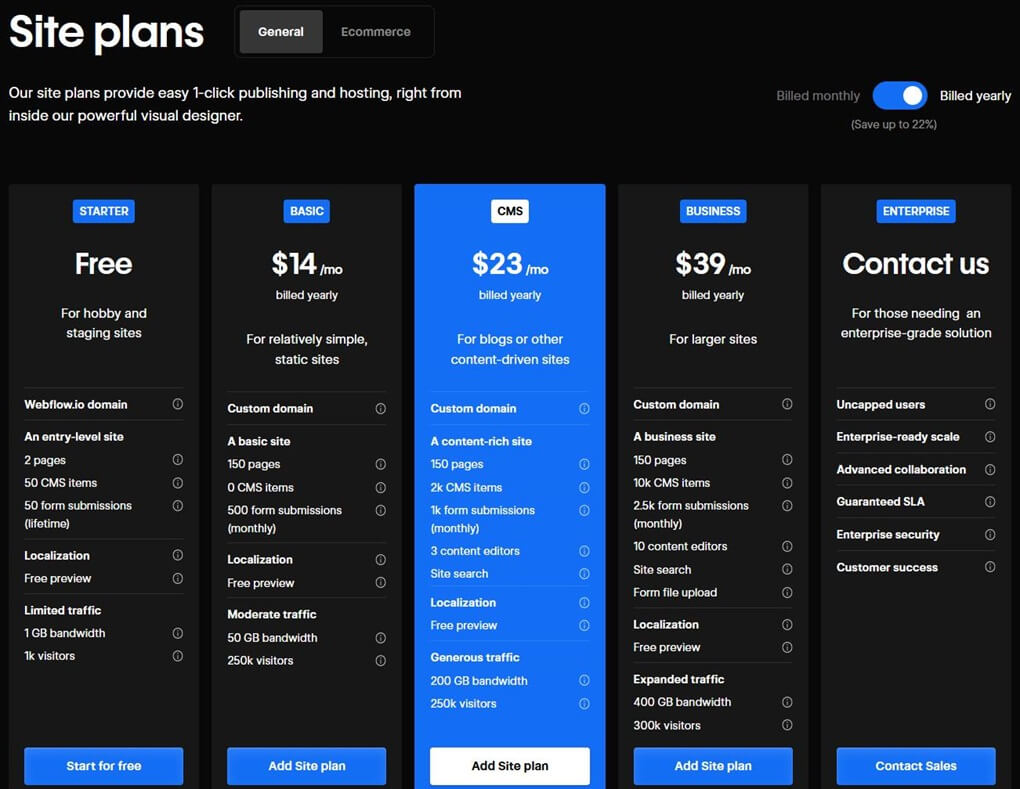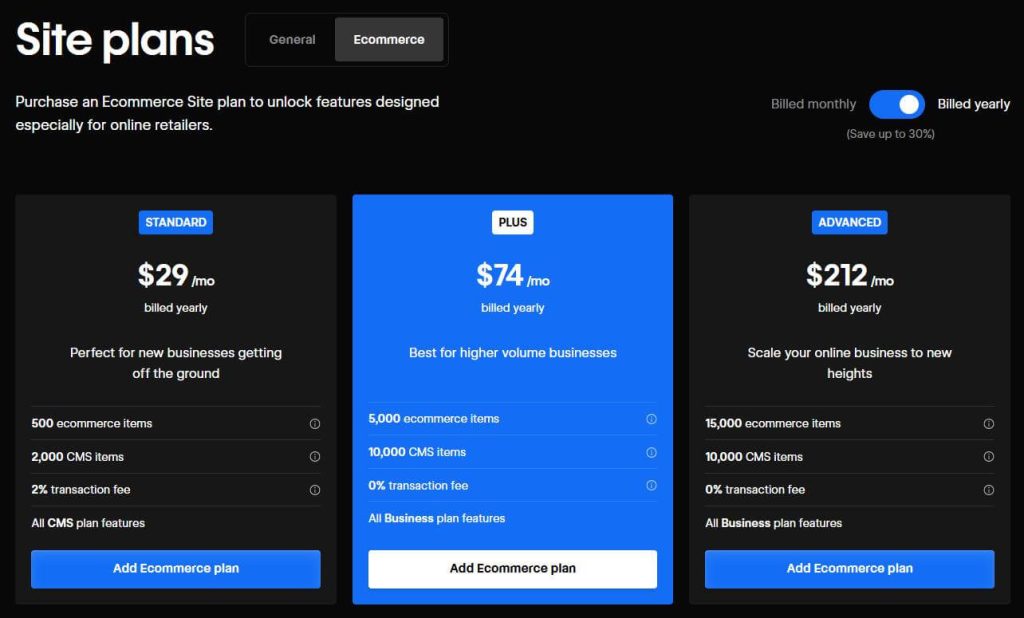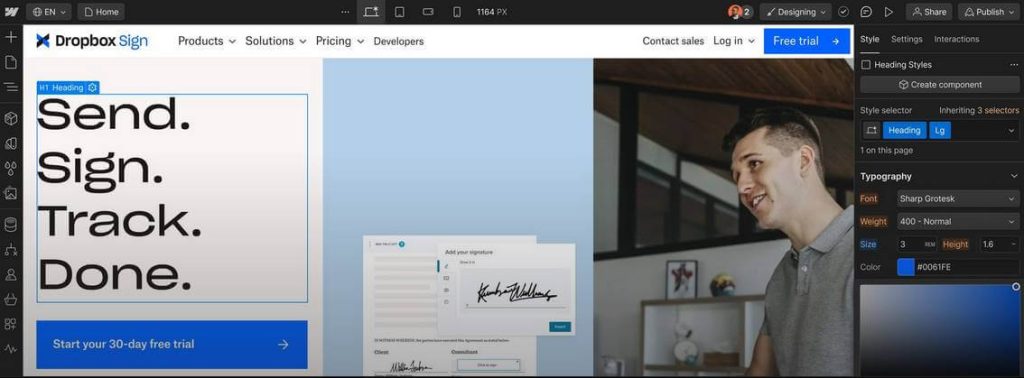
How Much Does Webflow Cost in 2024?
Curious about the cost of unleashing your website’s potential using Webflow? On one side, you have the basic plan starting at a wallet-friendly rate, offering essential features to get your site up and running.
However, on the flip side, if you crave more advanced functionalities like CMS capabilities or eCommerce tools, be prepared for a higher cost tier.
But don’t fret; these pricier plans come with added perks that can supercharge your online presence.
With various pricing tiers catering to different needs, finding the right fit for your project is key.
So let’s break down these costs and explore what each package brings to the table in this digital playground.
Start to build your dream website using Webflow
Key Takeaways
- Consider Your Needs: Evaluate your website requirements to choose the most suitable Webflow plan.
- Utilize Free Plan: Start with the free plan to get a feel for Webflow before committing to a paid option.
- Explore Ecommerce Features: If you plan to sell products online, delve into the Ecommerce plans for tailored solutions.
- Compare Competitors: Compare Webflow pricing with other website builders to ensure you’re getting the best value.
- Maximize Marketing Tools: Leverage Webflow’s marketing capabilities to boost your online presence.
- Make Informed Decision: Before investing in Webflow, weigh the features and costs against your website goals.
Understanding Webflow Pricing Plans
Different Plans for Various Website Needs
Webflow provides a range of pricing plans to suit different website requirements and cost. The pricing plans are tailored to accommodate varying levels of complexity and customization needed by users.
For instance, if you’re a small business owner looking to create a simple yet professional website, the basic plan might be suitable.
On the other hand, if you’re an e-commerce entrepreneur aiming for advanced features like custom code integration and increased web traffic capacity, opting for a higher-tier plan would be more beneficial.
Webflow’s diverse pricing options cater to both beginners who want user-friendly templates and tools as well as experienced developers seeking extensive design control and functionality.
Each plan offers distinct benefits that align with specific user needs.
Flexibility and Scalability
One advantage of Webflow’s pricing structure is its flexibility in accommodating users’ evolving needs.
As your website grows or requires additional features, you can easily upgrade your plan to access more advanced functionalities without having to switch platforms entirely.
This scalability ensures that your website can adapt alongside your business growth without facing limitations due to the platform’s constraints.
Moreover, Webflow’s pricing plans allow users the freedom to adjust their subscription based on seasonal demands or project requirements.
For example, if you have periodic spikes in web traffic during sales events or promotional campaigns, you can temporarily upgrade your plan for increased bandwidth and performance before reverting back once the event concludes.
- Offers plans for various needs
- Provides flexibility in upgrading
- Allows adjustments based on project requirements
Exploring Webflow Site and Workspace Plans
Site Plans for Individuals and Businesses
Webflow provides Site plans tailored to individuals and businesses aiming to build and host websites.
These plans cater to varying needs, from personal portfolios to e-commerce platforms. With different tiers available, users can select the plan that best suits their requirements.

For instance, the Basic Site plan might be ideal for a small business looking to establish an online presence with a limited budget. On the other hand, the Business Site plan could offer more advanced features like custom code capabilities or increased storage space.
Webflow’s Site plans grant access to a range of tools such as templates for quick website setup, SEO optimization features for better visibility on search engines, and responsive design options ensuring websites look great on any device.
Moreover, these plans often include hosting services that guarantee website uptime and security measures like SSL certification.
Pros:
- Tailored solutions for various needs
- Accessible tools like templates and SEO features
Cons:
- Higher-tier plans can be costly
- Limited customization options in lower-tier plans
Webflow Site plans Pricing
Monthly Payment
- Starter: Free
- Basic: $18 /month
- CMS: $29 /month
- Business: $49 /month
- Enterprise: Need to contact the Webflow team
Yearly Payment (Save up to 22%)
- Starter: Free
- Basic: $14 /month
- CMS: $23/month
- Business: $39 /month
- Enterprise: Need to contact the Webflow team
Workspace Plans for Collaborative Teams
For teams working collaboratively on multiple projects within Webflow, Workspace plans are designed specifically to streamline communication and project management tasks.
These plans enable team members to work seamlessly together by assigning roles based on responsibilities within each project.
The Team Workspace plan, for instance, allows multiple team members to have their seat while collaborating on different projects simultaneously.
In addition to facilitating teamwork through role assignments and collaborative tools like commenting sections or live editing features, Webflow’s Workspace plans also provide export functionalities that allow users to download project files or assets easily when needed outside of the platform.
Delving into Webflow eCommerce Plans
Tailored Ecommerce Features
Webflow’s Ecommerce plans cater specifically to online stores, offering a range of tailored features with monthly pricing.

These plans are designed to provide specific access to tools like inventory management, product variants, and secure payment gateways.
For businesses looking to establish an online store, these features are crucial for managing products effectively.
For instance:
- Inventory management ensures that businesses can keep track of their stock levels efficiently.
- Product variants allow customers to choose different options like size or color when making a purchase.
- Secure payment gateways guarantee that transactions on the website are safe and protected.
Webflow eCommerce plans Pricing
Monthly Payment
- Standard: $42 /month
- Plus: $84 /month
- Advanced: $235 /month
Yearly Payment (Save up to 30%)
- Standard: $29 /month
- Plus: $74 /month
- Advanced: $212 /month
Choosing the Right Plan
Selecting the appropriate Webflow eCommerce plan depends on various factors such as your budget, scale of operations, and specific requirements.
Businesses with a limited budget may opt for a basic plan initially while those with more extensive needs might go for a higher-tier plan offering additional functionalities.
Here is how you can decide:
- Evaluate your budget constraints before selecting an Ecommerce plan.
- Consider the scale of your online store – whether it’s small-scale or large-scale.
- Assess the specific features you require for smooth operation – such as inventory tracking or multiple payment options.
Pros:
- Tailored features designed specifically for online stores.
- Scalable plans catering to businesses of all sizes.
Cons:
- Costs may vary based on the selected plan tier.
Best Hosting Solutions
- Best High Speed Web Hosting by Hostinger
- Low Cost Web Hosting Solution for Everyone by NameCheap
- Next-Gen VPS Hosting Solutions by Liquid Web
- Exclusive Website hosting by Inmotion Hosting
Best Cloud Hosting Solutions
Start Your eCommerce Online Store
Shopify eCommerce Online Store Builder for just $1
Marketing Tools
SEO Tools
#1 All in One SEO Tool – Semrush
Unveiling Webflow Enterprise Plan Details
Features of Webflow Enterprise Plan
The Enterprise plan in Webflow targets large-scale businesses with specific needs, offering personalized support, enhanced security measures, and custom solutions.
This plan is highly customizable to cater to the unique requirements of each business.
For instance, if a company requires additional security features due to handling sensitive customer data, the Enterprise plan can be tailored to meet those needs effectively.
Webflow’s Enterprise plan stands out for its ability to provide businesses with a high level of support and customization options that are not available in standard plans.
The personalized support ensures that companies receive dedicated assistance promptly whenever they encounter issues or need guidance on utilizing the platform more efficiently.
The enhanced security measures included in this plan offer peace of mind for businesses dealing with confidential information or transactions online.
Customization Options
One significant advantage of the Webflow Enterprise plan is its flexibility in terms of customization.
Businesses can tailor their plan based on their specific requirements and objectives, ensuring they only pay for services that are essential to their operations.
This level of customization enables companies to optimize their spending by investing solely in features that directly contribute to their success and growth.
- Personalized Support
- Enhanced Security Measures
- Flexibility in Customization Options
Comparing Webflow with Other Website Builders
Main Difference
When comparing Webflow to other website builders, the main difference lies in its powerful design capabilities.
Unlike traditional platforms, Webflow offers more advanced customization options and control over the website’s design elements.
For instance, while some builders may limit you to preset templates, Webflow allows users to create unique designs from scratch.
One of the significant advantages of using Webflow is its ability to provide a higher level of flexibility compared to other website builders.
This means that users have more freedom in customizing their websites according to their specific needs and preferences.
With features like dynamic content and interactions, Webflow empowers users to create truly unique and engaging websites that stand out from the competition.
For example, if you are looking to build an e-commerce site with intricate design requirements such as animations or complex layouts, Webflow would be a better choice than many standard website builders.
The platform’s robust tools allow for pixel-perfect designs without compromising on functionality or user experience.
Free vs Paid Plan Options in Webflow
Different Plans for Different Needs
Webflow offers a free plan and several paid options starting at $29 per month to cater to various user requirements.
The free plan is ideal for beginners or those looking to explore the platform’s basic features without any financial commitment.
On the other hand, the paid plans come with enhanced capabilities that are beneficial for businesses or individuals with more advanced needs.
When considering how much does Webflow cost per month, it’s essential to evaluate what features you require for your website.
For instance, if you need advanced functionalities like e-commerce tools, custom code integration, or increased hosting capabilities, opting for one of the paid plans might be more suitable.
Assessing Your Requirements and Budget
To decide between the free and paid plans on Webflow, start by assessing your specific needs, budget constraints, and month.
If you are running a personal blog or a small portfolio website, the free plan might suffice initially.
However, as your website grows or if you require additional features such as removing Webflow branding or connecting a custom domain name, upgrading to a paid plan becomes necessary.
Pros:
- Flexibility to choose between free and various paid plans based on individual requirements.
- Ability to start with a free plan and upgrade as needed without losing progress made on your website.
Cons:
- The free plan comes with limitations such as restricted bandwidth and storage space.
- Upgrading to a paid plan incurs monthly costs depending on the selected tier but unlocks valuable features.
Customizing Websites with Webflow Features
Features for Customization
Webflow offers a variety of features to help you customize your website. These include drag-and-drop functionality and tools for responsive design.

By exploring these features, you can create a visually appealing and unique website that suits your needs.
Webflow’s user-friendly interface allows you to easily edit content on individual pages. This means you can make changes to specific parts of your site without affecting the entire layout.
For example, if you want to update an image on one page, you can do so without altering other elements.
Pricing Plans
It offers different pricing plans based on users’ needs. The platform has a free plan with limited features, which is great for beginners or those looking to test the waters before committing financially.
On the other hand, Webflow also provides paid plans with additional features like custom code integration and increased storage capacity.
Pros:
- Free plan available for beginners.
- Paid plans offer more customization options.
- Different pricing tiers cater to various user requirements.
Cons:
- Some advanced features are only available in paid plans.
- Costs may add up depending on the selected plan and additional services needed.
Evaluating Marketing Capabilities in Webflow Plans
Marketing Features in Webflow Plans
Webflow offers a range of marketing capabilities to enhance the visibility and reach of your website.
These include SEO optimization tools, which help improve your site’s ranking on search engines, making it easier for potential visitors to find you.
Webflow plans come with integrations with third-party services, allowing you to connect your website with popular marketing tools like Mailchimp or Google Analytics.
Furthermore, analytics tracking features enable you to monitor the performance of your website and campaigns effectively.
One way to make an informed decision about choosing a Webflow plan is by assessing the marketing capabilities each plan offers.
By understanding how these features align with your promotional goals and strategies, you can select a plan that best meets your needs.
For example, if driving organic traffic through SEO is crucial for your website’s success, opting for a plan that provides robust SEO tools would be beneficial.
Similarly, if you rely heavily on email marketing campaigns, selecting a plan that seamlessly integrates with email marketing platforms would be advantageous.
Choosing the Right Plan Based on Marketing Needs
When evaluating different Webflow plans based on their marketing capabilities, consider factors such as your target audience size and engagement goals.
If you have a small team managing the website but aspire to scale up traffic through targeted marketing efforts, opting for a plan that offers comprehensive analytics tracking could provide valuable insights into visitor behavior patterns and preferences.
Pros:
- Diverse marketing features available across various plans.
- Seamless integration with third-party services enhances marketing strategies.
Cons:
- Higher-tier plans may come at an additional cost but offer more advanced marketing tools.
Verdict: Is Investing in Webflow Worth It?
Value for Money
Webflow’s pricing plans offer value for the features they provide, making it a good investment. The platform prioritizes design flexibility and customization options, catering to various website needs efficiently.
For instance, the ability to create responsive designs without code is a significant advantage.
Considering your specific needs and budget will help determine if investing in Webflow is worthwhile.
The platform’s pricing structure aligns with different user requirements, ensuring that you pay for what you use.
This tailored approach makes it easier to find a plan that fits your budget while offering the necessary tools to build a professional website.
Factors Influencing Decision
When evaluating how much Webflow costs, factors such as time saved on development and maintenance should be considered.
While the initial cost may seem higher than other platforms, the long-term benefits of streamlined processes can outweigh this investment.
Furthermore, having access to reliable customer support can also save time and help resolve any issues promptly.
Frequently Asked Questions
How much does Webflow cost?
Webflow offers various pricing plans starting from $18 per month for basic websites to $49 per month for advanced business solutions. The cost varies based on the features and functionalities required.
What are the differences between free and paid plans in Webflow?
The free plan in Webflow is limited in terms of features, storage, and customization options. Paid plans offer more advanced functionalities such as custom domains, increased storage capacity, e-commerce capabilities, and access to premium support.
Is investing in a Webflow eCommerce plan worth it?
Investing in a Webflow eCommerce plan can be worthwhile if you are looking to create an online store with robust features like inventory management, secure payments, customizable checkout processes, and seamless integration with other tools.
How does Webflow compare with other website builders?
Webflow stands out among website builders due to its powerful design capabilities without requiring coding knowledge. It offers a visual development interface that allows for complete customization while maintaining responsive designs across all devices.
What marketing capabilities are included in Webflow plans?
Webflow provides essential marketing tools such as SEO optimization features, integrations with email marketing services like Mailchimp, and analytics tracking options through Google Analytics or Facebook Pixel integration. These tools help users enhance their online visibility and track performance effectively.
Closing Thoughts
You’ve now seen the ins and outs of Webflow’s pricing plans, from the basic to the enterprise level. It’s like choosing toppings for your favorite pizza – each plan adds a new layer of flavor to your website-building experience.
So, is investing in Webflow worth it? Well, that depends on how hungry you are for a top-notch website that stands out in the digital crowd.
Now that you’re armed with all this knowledge, go ahead and take the plunge into the world of Webflow.
Whether you’re a small business owner or a budding entrepreneur, finding the right plan can be a game-changer for your online presence. So, don’t be shy – dive in and let your creativity flow with Webflow!
